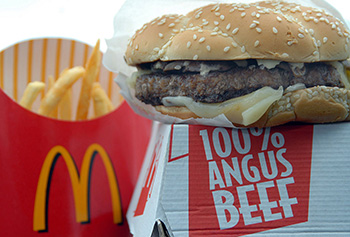(单词翻译:单击)

After phones, cameras and taxis, Silicon Valley is looking to disrupt a rather more mundane American mainstay: fast food.
继手机、照相机和出租车之后,硅谷正着眼于颠覆一种美国人生活中习以为常的东西:快餐。
Start-ups are trying to revolutionise the food industry and have received hundreds of millions of dollars in funding from venture capitalists to do so.
一批创业企业正试图掀起食品行业革命,并为此获得了风险资本家数亿美元的融资。
Many are motivated by a desire to wean humanity off meat and other foods that have big environmental and social impacts, whether in the methane emissions and land use of cattle herds or additives in typical processed food.
其中许多公司是受到这样的愿望驱使:让人类不再依赖会对环境和社会造成巨大影响的肉类及其他食品,不管是甲烷排放和养牛占地方面还是一般加工食品中的添加剂。
“The traditional food system is broken in every way,” says Seth Bannon, founding partner at Fifty Years, an early stage venture fund in San Francisco that has invested in food technology companies. “It’s terrible for the environment, it’s economically unfavourable and it’s not great for human health.”
“传统食物体系正在被从各个方面击破,”投资了几家食品科技公司的旧金山初创阶段风险基金Fifty Years的创始合伙人赛斯.班农(Seth Bannon)表示,“它对环境有害,不具备经济效益,而且对人类健康不是很好。”
The best-known of these would-be disrupters is also the most extreme in its approach. Soylent was founded in 2013 by a group of Silicon Valley engineers trying to cut the time and money they spent buying and preparing food. The company has expanded from producing a powder that was mixed with water to ready-made drinks and nutritional “food bar” snacks.
这些“准颠覆者”中,最有名的一家也是创新手法最极端的。Soylent由一群硅谷工程师于2013年创立,这些工程师想减少他们花在购买和准备食物上的时间和金钱。Soylent最初生产一种需要跟水混合的粉末状食品,后来发展为生产成品饮料和有营养的“食物棒”。
The company takes its name from a 1966 Harry Harrison science-fiction novel Make Room! Make Room!, which explores the impact massive population growth could have on world resources. In the book, “soylent” is made of soy and lentils and is used to feed the world. A film version in 1973, Soylent Green, took this theme further by portraying the main global food stuff as dead human beings being sold as biscuits.
Soylent之名取自1966年哈里.哈里森(Harry Harrison)的科幻小说《Make Room! Make Room!》,小说探讨了人口剧增可能给全球资源带来的影响。在书中,由大豆和扁豆制成的“soylent”成为全球的食物。1973年,小说被改编成了电影《绿色食品》(Soylent Green),影片进一步挖掘了上述主题,讲述死人被作为全球主要食物原料,制成饼干销售。
The Soylent company, now based in Los Angeles, says its “intelligently designed” food offers “affordable, complete nutrition”. A serving of its deliberately tasteless gloop costs as little as $2.
如今总部位于洛杉矶的Soylent公司表示,其“精巧设计”的食物能够提供“价格合适、全面的营养”。吃一顿该公司生产的故意做成没有味道的半流状食品最低只需花费2美元。
“It’s not surprising to me that Soylent has become the darling of Silicon Valley and computer programmers,” says Amy Bentley, a professor of food studies at New York University. For one thing, she says, it does away with the social interaction that food often involves but tech nerds are not renowned for. “You don’t have to talk to people, you can just fuel.”
“Soylent已成为硅谷和电脑程序员喜爱的食品,对此我一点也不奇怪,”纽约大学(New York University)食品研究教授艾米.本特利(Amy Bentley)表示。她说,首先,它消除了进餐往往会牵涉到的社交,毕竟这些干技术的书呆子们并不以社交能力闻名。“你不必跟人说话,你只管补充能量。”
However, Soylent has also illustrated some of the hazards of pioneering new food. Two months after they first went on sale, Soylent halted sales of its food bars after some customers said they had caused episodes of violent vomiting, and in October removed its powder drink from sale for the same reason.
然而,Soylent的经历也展示了在食品创新方面充当先驱可能面临的一些风险。该公司的“食品棒”首次上市销售才两个月,就因为有顾客抱怨食用后导致了强烈呕吐,不得不下架。今年10月,出于同样的原因,该公司撤下了其粉末饮品。
Soylent said that while its tests had come back “negative for food pathogens, toxins or outside contamination”, one ingredient, derived from algae, may have triggered intolerance. A new formulation will be released next year, sooner if possible.
Soylent表示,其检测显示在食品致病菌、毒素或外部污染物等方面结果为阴性,但一种取自海藻的成分可能引起人体不耐受。新配方将于明年发布,如果可能的话会更早。
“We are just beginning to learn about what our bodies need,” says Ms Bentley. “Turns out when we try to engineer stuff, we figure out nature did it pretty well in the beginning.” She adds: “Humans need variety.”
“我们只是刚开始了解我们的身体需要什么,”本特利表示,“当我们试图设计制造食物材料时,结果我们才发现自然从一开始就做的非常好。”她补充称:“人类需要多样性。”
Rivals have also emerged, including Ambronite, a nutritional drink, and 100%Food, whose maker, Space Nutrients Station, invites customers to “stop cooking — eat like astronauts!”.
竞争对手也出现了,包括营养饮料Ambronite以及100%Food,后者的制造商Space Nutrients Station邀请消费者“不要做饭了——像宇航员一样吃!”
“The idea is that Ambronite can be any meal, says its co-founder Simo Suoheimo, “ but the idea is not to replace every meal.”
“我们的想法是Ambronite可以代替任何一餐饭,但不是代替每一餐饭,”Ambronite创始人西莫.索海莫(Simo Suoheimo)表示。
Ambronite has received $600,000 from backers, including a co-founder of YouTube, Jawed Karim, and Lifeline Ventures, while Soylent has raised more than $20m. But other food technology companies have been more ambitious. Investors have poured more than $180m into Impossible Foods, which is trying to replace meat with something that tastes and smells similar but is made from plants.
Ambronite已收到投资者60万美元资金,包括YouTube联合创始人贾韦德.卡里姆(Jawed Karim)和Lifeline Ventures,而Soylent已募集逾2000万美元。还有更加野心勃勃的食品科技公司。投资者已向Impossible Foods注资逾1.8亿美元,这家公司试图用味道和气味与肉类相似、但由植物制成的食品来替代肉食。
Ingredients such as potatoes and coconuts are fermented then combined with the “magic ingredient” of heme, a yeast extract with similar culinary properties to blood.
土豆和椰子等原料被发酵,然后与血红素这种“神奇原料”混合,这是一种酵母提取物,具有与血类似的烹调特性。
“You can’t get people to stop eating meat,” says Pat Brown, Impossible Foods’ founder and chief executive.
Impossible Foods创始人及首席执行官帕特.布朗(Pat Brown)表示:“你不能不让人们吃肉。”
“We turn plants into meat more efficiently and sustainably” than animals, he says.
他表示:“我们以比动物更高效、更可持续的方式将植物转化为肉类。”
However, copying nature has proven tougher than Mr Brown may have anticipated. Impossible’s burgers have already been five years in the making, and only now are starting to be offered in selected, expensive restaurants.
然而,事实证明,复制“自然”要比布朗想象的还要难。Impossible的汉堡已研制了5年,现在才开始在精选的高档餐厅供应。
A commercial-scale manufacturing facility will not open until next year. In the meantime, a pilot facility is producing 1,200lb a week. Over the past two years, Impossible has reformulated its burgers’ ingredients and reduced costs.
具备商业化生产规模的制造工厂要等到明年才能投入运营。与此同时,一间实验工厂每周的产量为1200磅。过去两年中,Impossible修改了汉堡包的成分,降低了成本。
“A cow is pretty much as mature a technology as it will ever be,” Mr Brown says. “One of the huge advantages we have over cows when it comes to making meat is we have the capability of improving every aspect of it.”
布朗说道:“一头牛的技术成熟程度将永远像现在这样,相比牛,我们在制造肉食方面的巨大优势之一是我们有能力从每一个方面来改善产品。”
Another start-up disrupting nature is Memphis Meats. The Bay Area-based company is taking a different approach — growing meats in a lab, cultivating them from real animal cells.
另一家颠覆自然的初创企业是Memphis Meats。这家总部位于旧金山湾区的公司正采用一种不同的方法:在实验室培育肉类,利用真正的动物细胞培养。
“We identify cells that have the capability to renew themselves,” says Uma Valeti, Memphis’ co-founder and chief executive. “We breed those cells that are the most effective and growing — just like a farmer would do with animals.” Eventually, he hopes to remove animals from the equation altogether.
“我们会找出那些有能力自我再生的细胞,”Memphis联合创始人兼首席执行官乌玛.瓦列提(Uma Valeti)表示,“我们培育那些效率最高且在增长的细胞,就像农民饲养动物那样。”他希望最终从人们的食物来源中彻底剔除动物。
Previous efforts to cultivate meat in this way have produced burgers that cost thousands of dollars. Memphis Meats hopes to drive down the price of its meatballs from a projected $40 a gramme in the lab-scale to a few cents per gramme by the end of the decade.
以前用这种方式培育肉类的努力,制作出的汉堡成本高达几千美元。Memphis Meats希望到本10年末,将其肉丸价格从预期的实验室规模的每克40美元降至每克几美分。
Mr Bannon, of Fifty Years, who has invested in Memphis Meats, calls its approach the “second domestication”. “Traditionally we have domesticated animals to harvest their cells for food or drink,” he says. “Now we are starting to domesticate cells themselves.”
上文提到的风投基金Fifty Years就投资了Memphis Meats,其创始人班农把这种方法叫做“二度饲养”。“我们饲养了动物,把它们的细胞制成食物或饮料,”他表示,“如今,我们正开始饲养动物细胞本身。”


